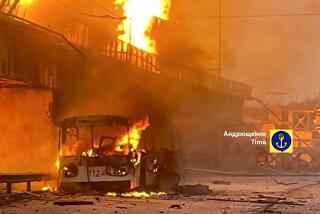Disaster Seen Hurting Gorbachev Arms Clout : Radiation Outside ‘Danger Zone’ Poses No Threat--Moscow
- Share via
MOSCOW — The Soviet government said Wednesday that radiation levels more than 19 miles around the damaged Chernobyl reactor have risen above normal but pose no threat to public health.
The Council of Ministers said in a statement that the higher radioactivity occurred only in areas “directly adjoining” the danger zone--the area within a 19-mile radius of the plant. Most of the people in the zone were evacuated a week ago Sunday as a precautionary measure.
Despite the assurances, travelers from Kiev, 60 miles south of Chernobyl, said that some parents there were sending their children away because of radiation fear.
Kiev, the capital of the Ukraine, is said to be recording radiation levels slightly above normal, and the Ukrainian Health Ministry advised people not to remain outdoors for prolonged periods. It also suggested that leafy vegetables from the Kiev region be washed with care.
Increased Apprehension
The instructions, following a week of televised official assertions that Kiev was suffering no ill effects from the Chernobyl incident, appears to have increased apprehension among the city’s 2.5 million people,
One of the four reactors at the plant experienced an explosion and fire early in the morning of April 26, but the Kremlin did not acknowledge the accident until two days later, after a radioactive cloud had spread over part of Eastern Europe and Scandinavia. The Soviet government has said two people were killed, 204 hospitalized and 49,000 evacuated from the 19-mile-radius area around the site.
The Chernobyl danger zone has been the scene this week of a wide variety of decontamination measures.
Roads throughout the Kiev area were washed down, and each of the estimated 49,000 people evacuated from the area was put through a decontamination procedure, the official Soviet news agency Tass reported.
“According to official figures, there is no threat to the health of the absolute majority of the evacuees,” Tass said.
Vegetables were being checked twice for radiation, the agency said, once in the field and again before being placed on grocery store shelves.
Students from Britain, the United States, Canada and other Western countries have left Kiev since the radiation leak at Chernobyl was announced April 28. Tass said the students are in good health and not worried.
In the Soviet Union, sources have noted, such elaborate official reassurances and the practice of dribbling out information on a piecemeal basis tend to arouse suspicion rather than allay fears.
“We are always wondering what they have not announced,” a source in Moscow said. He said he knows several people in Kiev who are leaving the city for the summer months because of concern over the fallout from Chernobyl.
In the United States, National Public Radio reported Wednesday that the meltdown of the Chernobyl reactor core has apparently burned its way through the concrete-and-steel foundation beneath it. The report said Soviet scientists have approached West German scientists and diplomats seeking advice on dealing with the situation.
‘China Syndrome’ Scenario
According to one nuclear-accident scenario, popularized by the movie “The China Syndrome,” a reactor meltdown could produce massive contamination of ground water when the radioactive core sears its way into the Earth.
Meanwhile, Soviet nuclear energy officials met with Hans Blix, director of the International Atomic Energy Agency, to discuss the reason for the accident and the resulting radiation hazards.
A spokesman for the agency, headquartered in Vienna, said Moscow now appears to be cooperating with the IAEA and providing more information than in the first week following the accident.
Soviet newspapers disclosed additional details of last Sunday’s evacuation, which took 49,000 people out of the danger zone in 1,100 buses that formed a cavalcade 12 miles long.
Accounts in the Soviet press indicate that some people left their homes with little more than the clothes on their backs.
Grigory Revenko, the Communist Party leader in the Kiev region, was quoted in the newspaper Soviet Russia as saying, “There was some lack of coordination . . . in providing the evacuees with the basic necessities, especially clothing and footwear.”
Peasants were sometimes reluctant to leave their homes, Revenko said, and added:
“We could not take risks with people and their health. Therefore, in many cases we had to persuade them.”
Heroic Performances
Some people shirked their duty, he said, while others performed heroically.
“You cannot hide a sin,” Revenko said. “Individual workers were found who in the difficult conditions did not display the necessary steadfastness and willingness to be at the front line.”
The Council of Ministers said in its report that the radiation situation at Chernobyl “continues to improve” because of cleanup measures. But the international agency spokesman said that its three experts in Moscow will not visit the site because radiation levels there are too high to permit an inspection.
A team of American specialists in bone-marrow transplants are continuing to provide treatment for people who received heavy doses of radiation at Chernobyl. Dr. Robert P. Gale of UCLA said three other specialists have arrived to help him perform the transplant surgery.
Gale said in a telephone interview that two of his UCLA colleagues, Dr. Paul I. Terasaki, a tissue-matching specialist, and Dr. Richard Champlin were working with him and Soviet physicians. Dr. Yair Reisner of the Memorial Sloan-Kettering Cancer Center in New York has joined the group, Gale said.
“We are quite pleased with the quality of our Soviet colleagues, and we are quite pleased we got help so quickly,” Gale said. “A lot of equipment, drugs and other supplies already have arrived, and we’re working like dogs.”
He said all his patients so far have survived. And he said he is not aware of any deaths among the 100 people brought to Moscow for emergency treatment.
More to Read
Sign up for Essential California
The most important California stories and recommendations in your inbox every morning.
You may occasionally receive promotional content from the Los Angeles Times.










